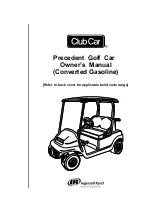
STEERING AND FRONT SUSPENSION
Front Suspension
7
3.
Measure distance (A) between the edge of the square and a top location on the inside bead of the wheel rim.
Record that measurement.
See following NOTE.
NOTE:
Do not measure against the wheel rim edge or tire sidewall. Both of these can have variations in their surfaces
that will result in inaccurate dimensions.
4.
Measure distance (B) in the same method as distance (A), using the same reference on a bottom location on the
inside bead of the wheel. Record that measurement.
See following NOTE.
NOTE:
If dimension (A) is greater than dimension (B), the camber is positive. A negative camber is desirable,
with dimension (A) being less than dimension (B).
5.
The negative camber for this vehicle should be from zero to 0.275 inch (7.0 mm) maximum.
See following NOTE.
NOTE:
A good average dimension for this specification is 5/32-inch (4 mm) negative camber on each wheel.
Camber Adjustment
1.
Locate the bolts that secure the flat camber adjustment bar in position at the underside of the lower A-arm.
Loosen the bolts just enough to allow the bar to move with some resistance
2.
Insert the cam tool (CC P/N 102447101) into the adjustment slot on the lower A-arm assembly.
3.
Rotate the cam tool to adjust the bar until the desired dimension is achieved and the camber position is positive.
4.
Tighten the camber adjustment bar bolts to 53 ft-lb (72 N·m).
5.
Check the measurement on the camber, and repeat steps 1 through 4 if necessary.
6.
Repeat steps 1 through 5 for the remaining front wheel.
B
A
2063
Figure 7-32
Measure Camber
2062
Figure 7-33
Adjust Camber
2016 Carryall 1500/1700 and XRT 1550 Maintenance and Service Manual
Page 7-17
Содержание Carryall 1500 2016
Страница 2: ......
Страница 432: ...NOTES...
Страница 433: ...NOTES...
Страница 434: ...NOTES...
Страница 435: ......
Страница 436: ......


































